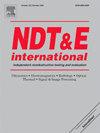Finite element analysis of wave propagation in austenitic stainless steel welds with three-dimensional solidification structures predicted by cellular automaton method
IF 4.1
2区 材料科学
Q1 MATERIALS SCIENCE, CHARACTERIZATION & TESTING
引用次数: 0
Abstract
Austenitic stainless steels have been extensively used in nuclear power plants, and therefore, their welds must undergo ultrasonic testing (UT). However, conducting UT on the far side of these welds poses significant challenges. A thorough understanding of wave propagation in these welds is essential for enhancing the performance of UT. In this study, we executed precise three-dimensional simulations of wave propagation within welds containing a solidification structure using the finite element method (FEM). A three-dimensional cellular automaton finite difference model was developed for predicting the solidification structure of multilayer and multipass austenitic stainless-steel welds (ASSW) based on the welding process. This model incorporated elements such as heat flow, grain growth, grain melting, and alloy addition during welding. Further, it accurately replicated the experimental peak temperature at measurement points near a welding groove for an SUS316L ASSW featuring seven layers and seven passes. The predicted solidification structure for the SUS316L ASSW closely matched actual macrographic results. We integrated the forecasted solidification structure into an FEM code to simulate wave propagation in ASSW, and we compared the numerical outcomes with experimental findings for both normal and angle beam testing. The numerical results precisely mirrored the experimental observations. Longitudinal waves traversed the welds smoothly, whereas shear waves encountered significant disruption. In addition, the intensity of all echoes determined through the numerical analysis aligned closely with the experimental results, exhibiting a variation of less than 2 dB.

求助全文
约1分钟内获得全文
求助全文
来源期刊

Ndt & E International
工程技术-材料科学:表征与测试
CiteScore
7.20
自引率
9.50%
发文量
121
审稿时长
55 days
期刊介绍:
NDT&E international publishes peer-reviewed results of original research and development in all categories of the fields of nondestructive testing and evaluation including ultrasonics, electromagnetics, radiography, optical and thermal methods. In addition to traditional NDE topics, the emerging technology area of inspection of civil structures and materials is also emphasized. The journal publishes original papers on research and development of new inspection techniques and methods, as well as on novel and innovative applications of established methods. Papers on NDE sensors and their applications both for inspection and process control, as well as papers describing novel NDE systems for structural health monitoring and their performance in industrial settings are also considered. Other regular features include international news, new equipment and a calendar of forthcoming worldwide meetings. This journal is listed in Current Contents.
 求助内容:
求助内容: 应助结果提醒方式:
应助结果提醒方式:


